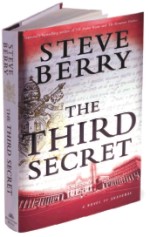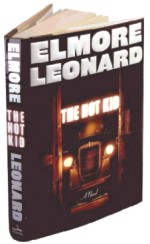|
Books
DetectiveStories
 The
Third Secret The
Third Secret
Steve Berry
Random House Publishing Group; May 2005
Visions
of the Virgin Mary, secret documents and politicking in the
highest echelons of the Catholic Church-Berry (The Amber Room)
combines combustive elements in this well-researched thriller.
In 1917, the Virgin Mary revealed herself to three children
in Fatima, Portugal, disclosing three secrets to the eldest,
Lucia, who shared the first two secrets soon after their revelation
but left the last to be disclosed upon her death. This third
secret was released to Pope John XXIII in 1960 and made public
by Pope John Paul II in 2000--or was it? The novel's stolid
protagonist-Msgr. Colin Michener, longtime secretary to Clement
XV, the novel's near-future successor to John Paul II has
reason to doubt the accuracy of the public version of the
secret. Beleaguered by radically dogmatic cardinals and bishops,
the embattled Clement XV also appears distressed by recent
knowledge of secret documents regarding the Fatima messages.
Before his inexplicable suicide, Clement sends Michener to
Romania in search of a Father Tibor, who translated the third
secret for Pope John XXIII and may hold the key to its mystery.
Also on the case, if a step behind, is the ambitious and traditionalist
Vatican secretary of state, Cardinal Valendrea, with an eye
on the papal throne. Da Vinci Code fans hungry for more may
want a taste of this.
 The
Hot Kid The
Hot Kid
Elmore Leonard
HarperCollins Publishers; May 2005
Leonard's
40th novel, set in the world of 1930s gangsters and gun molls,
features characterizations so deft and true you can smell
the hair oil on the dudes and the perfume on the dames. Young
Carlos Webster tangles with his first gangster at 15, when
bank robber Emmet Long robs an Okmulgee, Okla., store, kills
an Indian policeman and takes away Carlos's ice cream cone.
Seven years later, Carlos, now Carl, a newly minted deputy
U.S. marshal, gets his revenge by gunning Long down, an act
that wins him the respect of his employers and the adulation
of the American public, who follow his every quick-draw exploit
in the papers and True Detective magazine. Cinematically,
Leonard introduces his characters-Carl's colorful pecan-farmer
father, Virgil; Jack Belmont, ne'er-do-well son of a rich
oilman; True Detective writer Tony Antonelli; Louly Brown,
whose cousin marries Pretty Boy Floyd-in small, self-contained
scenes. As the novel moves forward, these characters and others
begin to interact, forming liaisons both romantic and criminal.
At the stirring conclusion, scores are settled and the good
and the bad get sorted out in satisfactorily violent fashion.
The writing is pitch-perfect throughout: "It was his
son's quiet tone that made Virgil realize, My Lord, but this
boy's got a hard bark on him." The setting and tone fall
somewhere between Leonard's early westerns and his more recent
crime novels, but it's all pure Leonard, and that means it's
pure terrific.
(Source: ETC, Gulshan 1, Dhaka.)
 A
Stroke of Midnight A
Stroke of Midnight
Laurell K. Hamilton
Ballantine Books, Inc.; April 2005
Solving
a double homicide, avoiding assassins and coping with growing,
sometimes uncontrollable, power keep faerie private detective
Princess Meredith NicEssus (Meredith Gentry) busy in the fourth
and strongest entry in Hamilton's series (after 2004's Seduced
by Moonlight). When someone murders a fey and a reporter during
a press conference inside the Unseelie's headquarters, Merry
calls in the cops to assist (and inadvertently involves the
FBI as well). But once on magical turf, human police face
challenges and dangers of which the princess was unaware.
Meanwhile, Merry lives up to the five fertility deities in
her lineage and lustily fulfills her royal duty of mating
with males and making sex beyond mere human comprehension.
As Merry matures, the meaning of all the sex and magic comes
into more effective focus, as does Hamilton's underlying mythos
of the restoration of the faerie race's true power. The absence
of complicated politics results in a more palatable plot than
in previous volumes. Faeries, fornication and forensics fuse
for yet another darkly fantastic frolic for Hamilton fans.
Compiled
by: Sanyat Sattar
Copyright
(R) thedailystar.net 2005
|
